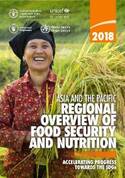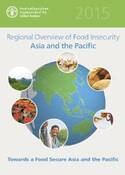Asia and the Pacific Regional Overview of Food Security and Nutrition
The annual Asia and the Pacific Regional Overview of Food Security and Nutrition is a co-publication jointly prepared by FAO, UNICEF, WFP and WHO to inform stakeholders on progress towards ending hunger, achieving food security and improving nutrition and to provide in-depth analysis on key regional challenges for achieving these goals in the context of the 2030 Agenda for Sustainable Development. The report targets a wide audience, including policy-makers, international organizations, academic institutions and the general public.

Asia and the Pacific - Regional Overview of Food Security and Nutrition 2022
2022, 168 p
Download report - English version
Download report - Chinese Version
This is the fifth edition of the Asia and the Pacific Regional Overview of Food Security and Nutrition annual report. This publication is led by FAO’s Regional Office for Asia and the Pacific (RAP) and jointly contributed to by United Nations' partner agencies (UNICEF, WFP, WHO), on the region’s progress (or lack thereof) to achieve the Sustainable Development Goals (in particular SDG 2 – Ending Hunger) and the World Health Assembly (WHA) 2030 targets on food security and nutrition. In recent years, previous editions reported that progress was stalling, then regressing and then more recently pushing us further off track. This reverse was evident even before the COVID-19 pandemic took hold in 2020. The decline continued and worsened during the pandemic and the data is captured in this report. Updated estimates on the cost and affordability of a healthy diet show that nearly 45 percent of the region’s population cannot afford one. Reducing the cost of a healthy diet and making it more affordable is a critical element for achieving ending hunger (SDG2) and also the other SDGs. This year’s report also looks closely at food security and nutrition in urban areas which will increasingly contribute to the progress in SDG indicators as the proportion of the urban population across the region is set to cross 50 percent in this decade.
Asia and the Pacific - Regional Overview of Food Security and Nutrition 2021
2021, 66 p.
This most recent report on the state of food security and nutrition in Asia and the Pacific tells a grim story. An estimated 375.8 million people in the region faced hunger in 2020, which is nearly 54 million more people than in 2019. In this region alone, more than 1.1 billion people did not have access to adequate food in 2020 – an increase of almost 150 million people in just one year. The high cost of a healthy diet and persistently high levels of poverty and income inequality continue to hold healthy diets out of reach for 1.8 billion people in this region.
The pre-existing food security and nutrition situation in Asia and the Pacific in 2019 was already quite discouraging. Progress had stalled in reducing the number of undernourished, and the prevalence of certain nutritional indicators, such as stunting in children under five years of age, was much too high. Since then, the situation has worsened. While it is not yet possible to fully quantify the impact of the COVID-19 pandemic in 2020, clearly it has had a serious impact across the region.
2021, 120 p.
The 2020 report on the State of Food Security and Nutrition in the Asia and Pacific region, provides an update on progress towards the 2030 targets (SDGs and WHA) at the regional and country level. Selected indicators look at undernourishment, food insecurity, childhood stunting, wasting and overweight, adult overweight, child minimum acceptable diet, exclusive and continued breastfeeding, and anaemia in women and children.
In Part 2, the 2020 report promotes a systems approach to healthy maternal and child diets, involving and coordinating institutions and actors in the Food, Water and Sanitation, Health, Social Protection and Education systems, to collectively create the enabling environment for healthy diets. Integration of healthy diets and nutrition-focused Social Behavior Change Communication (SBCC) mainstreamed throughout these systems will lead to greater uptake and sustainability of healthy behaviours and caregiver’s knowledge.
2019, 84 p.
Asia-Pacific is home to well over half of all people worldwide who do not obtain sufficient dietary energy to maintain normal, active, healthy lives. To achieve SDG 2 in the region, more than 3 million people must escape hunger each month from now until December 2030.
Social protection is an important way of reducing inequality and mitigating the impacts of disasters, and it is expanding in the regionA special section of this report discusses how to develop social protection programmes that accelerate progress in eradicating hunger and malnutrition.
2018, 96 p.
During the last three years, progress at reducing undernourishment has slowed tremendously in Asia and the Pacific. After years of gains in combatting hunger, progress has stagnated in all parts of this vast region. Despite decades of economic growth, nearly half a billion people remain undernourished.
Children, in particular, continue to face the burden of malnutrition – this region is home to more than half of the world’s malnourished children – with one child in every four below the age of five suffering from stunting. . At the same time, and almost paradoxically, Asia and the Pacific has witnessed rapid growth in the number of overweight children and the serious consequences that entails for their future health and well-being. This double burden of malnutrition sees undernourished and overweight children living in the same communities and households and it can even occur within the same child.
Efforts to fight hunger and malnutrition must go hand in hand with those to build and sustain peace and there is an urgent need to accelerate and scale up actions that strengthen resilience and adaptive capacity of people and their livelihoods to climate variability and extremes.
As migration from rural to urban areas continues apace, particularly involving poorer families, urban malnutrition is another challenge facing many countries.
2017, 68 p.
The special theme of this year’s report is Reducing Food Loss and Waste. Considerable analytical work has been undertaken on this issue during the past 4-5 years, reaffirming the initial claims that reducing food loss and waste offers a triple win – for food security, higher income for farmers and supply chain actors, and the environment. The special section reviews existing knowledge on the extent of food loss and waste in the region, examines their definitions and measurement challenges, and considers existing policy/programme initiatives.
2016 Regional Overview of Food Insecurity Asia and the Pacific:Investing in a Zero Hunger Generation
2016, 64 p.
The year 2015 marked the end of the global Millennium Development agenda and 2016 heralds a transition to the new 2030 agenda for Sustainable Development. Asia-Pacific Region not only met the MDG target of halving the proportion of people suffering from hunger, but was also the region with the largest reduction in the number of undernourished people in the world. Despite good progress being made by many countries in tackling malnutrition, the overall rate of progress is less than desired and the re are several countries and sub-regions where the prevalence rates are still very high. The analysis presented in this report will help encourage dialogue and shape a new public narrative towards eradicating hunger and malnutrition and creating a transformative change for sustainable development.
This report also introduces a special section which will focus on a different selected key issue or trend affecting food security and nutrition in the region each year. This year, the focus is on the importance of milk and smallholder dairy in view of the remarkable growth in the production and consumption of milk and milk products in the region. The section concludes that the promotion of milk consumption and small-scale dairying offers potential for triple wins in nutrition, rural livelihoods and the environment.
2015, 42 p.
This regional overview has been prepared to take stock of the current food security situation, present the challenges of ensuring food security in the context of growing and changing patterns of food demand, and propose key measures that must be taken in a coordinated manner by different stakeholders in this very dynamic and populous part of the world. Part I presents the region’s progress in meeting the Millennium Development Goal 1 and the World Food Summit targets in reducing the proportion a nd number of undernourished, respectively. Part II discusses insights from a suite of indicators related to the four dimensions of food security (food availability, access to food, stability and utilization); the future outlook towards 2050; policies, actions, commitments and initiatives by countries and regional organizations to address existing and emerging food security challenges; and finally, the path ahead to eradicating hunger and ensuring food and nutrition security in the region.







